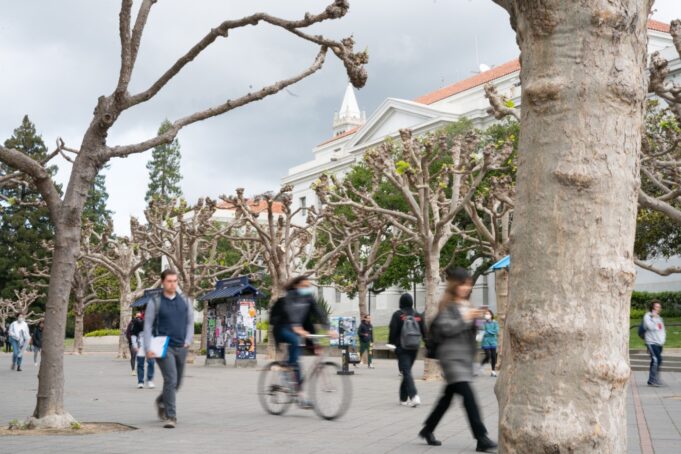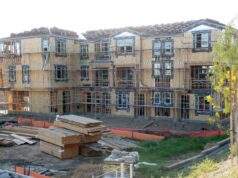Tara Nguyen
Editor’s note: This story was produced for Mosaic Vision, a pilot project of the Mosaic Journalism Workshop for Bay Area high school students. Students in the program report and photograph stories under the guidance of professional journalists.
After a new state law enabled the University of California-Berkeley to sidestep a court-ordered enrollment cap, incoming freshman Angela Huynh felt relieved. She would be attending her dream school after all.
But the housing shortage that had prompted the enrollment freeze in the first place didn’t go away. Neither did the battle between Berkeley residents and the university on how to address the issues. And students are still caught in the middle.
For unhoused students, attending Berkeley presents hardships that complicate daily academic life at a prestigious sought-after university.
Huyhn is still excited about going to Berkeley in the fall, but she worries about where she will live after her freshman year. First-year students are guaranteed housing in a dorm. She, like many others, wishes for solutions to the housing shortage.
“I feel like overcrowding doesn’t just happen out of nowhere,” she said. “Like it’s been this way for a long time.”
As a senior at Silver Creek High School in San Jose, Huynh heard stories and read reports in local media about Cal’s housing shortage. Students endure two-hour commutes in cars and public transit, pay thousands of dollars a month for a bed in an overcrowded house, couch-surf at friends’ houses and even live in their cars.
Sabrina Hoang-Lan Jones calls herself a “double bear,” for attending UC Berkeley for her undergraduate studies and currently for law school.
“Ever since the guaranteed housing my first year as an undergrad, housing has been a struggle,” Jones said. “My senior year, I was in a one-bedroom apartment with four gals total, two in the bedroom and two in the living room.” The cost for each person was $800 a month.
Currently, Jones is living in a room by herself, but the building offers a communal kitchen and bathroom. However, finding this place did not come easy. Every year she scours websites, including Craigslist and other Berkeley housing pages, all of which are riddled with scams. She thinks the most reliable listing is a Google spreadsheet made by Berkeley students.
Not only is it tough to find somewhere suitable to live, but landlords don’t always welcome a nine-month lease to align with the university’s academic calendar.
“I am lucky that I live relatively close to Berkeley in order to visit apartments in person, but I often have to make more than one trip visiting six to 10 apartments,” Jones said.
The UC Berkeley housing shortage and admissions policies pit residents who want the university to build more student housing before admitting more students against the university, that argues it has been building housing and doesn’t want to turn away thousands of students from its incoming freshman class.
Phil Bokovoy, president of the neighborhood group Save Berkeley’s Neighborhoods, says the group is going to keep pushing the school with further litigation. He expressed disappointment that they were not able to receive a legally binding commitment to build affordable housing.
“There are 9,000 beds, and 45,000 students. They need to catch up on housing and they shouldn’t keep adding to Berkeley unless they can catch up,” Bokovoy said. Residents pointed to more traffic, trash, noise and other impacts of the increase in numbers of Berkeley students.
From 2013 to 2021, the university increased annual admissions by roughly 3,000 students. UC Berkeley launched a housing initiative in 2018 to address the shortage of housing and has a number of projects in progress.
“The university has acknowledged that we have a student housing crisis. We are spending hundreds of millions of dollars to build as much student housing as quickly as possible in close proximity to the campus,” said Dan Mogulof, assistant vice chancellor.
“It will ensure there are beds and university dorms for all freshmen and sophomores,” he said. For transfer students, the university has begun building a large student residence hall. “We will begin construction in People’s Park of another student dorm that will hold 1,000 beds. We just brought online new graduate housing in Emeryville,” Mogulof said.
That’s little comfort to students who need housing now. They continue to live out of their cars, in substandard housing or face long commutes that disconnect them from other students, faculty and activities on campus.
Students who struggle to find housing do have resources available to help with basic needs, said Adam Ratliff, assistant director of media relations, critical communications and student affairs communications.
“The well-being of our students is critical, and we want to make sure students know there are resources available year-round,” he said. The university offers services including a food pantry and an emergency rental assistance program. Students can also get help accessing outside services such as the Basic Needs Center, and a peer-to-peer program, “Bears for Financial Success,” that provides workshops on helping students manage finances.
Betsy Putnam, housing supervisor of the Berkeley Co-op, offers affordable housing independent from the university, with 20 houses serving the area. The Co-op’s largest houses serve 260 students each, and the smallest has 17 students.
“[For] people who really need that extra hand going to college. Finding affordable housing will make a difference to their ability to attend Cal or another local university,” Putnam said. Even with on-campus resources available, some students are worried about how they are going to find housing.
Incoming freshmen like Huyhn, the Silver Creek High graduate, hope the situation will improve before she is set to graduate from UC Berkeley in 2026.
“If I am without housing in the coming years,” she said, “I will have to commute multiple times a week from San Jose just to attend classes.”
Tara Nguyen is a 2022 graduate of Silver Creek High School and will attend Emerson College in the spring.











